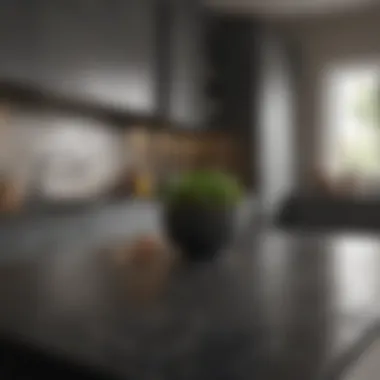Understanding Kitchen Renovation Costs for Homeowners


Intro
As you read, you will discover valuable budgeting strategies, considerations around return on investment, and practical advice that equips you for effective planning. Knowledge about these factors will support you in making informed decisions that align with your goals.
Design Inspiration
When one thinks about a new kitchen, design inspiration often comes to mind. The look and feel of the kitchen can heavily influence both the total cost and the end satisfaction of the renovation. Popular trends in kitchen design often vary by year, but a few core styles have persisted and remain desirable among homeowners.
Trending Styles and Themes
In the realm of kitchen design, certain styles capture attention consistently. Here are a few:
- Modern Minimalism: Characterized by clean lines, uncluttered spaces, and functional pieces. This style often uses fewer materials which can minimize costs.
- Rustic Charm: Often includes natural materials like wood. This style can range in affordability, depending on the peculiarity of the sourced materials.
- Industrial Edge: Combines metal and wood for an edgy look. The blend of materials can impact pricing, particularly if reclaimed materials are sought after.
- Classic Elegance: Features timeless cabinetry and finishes. While it leans towards higher costs, its longevity may justify the investment.
Choosing a style that fits your aesthetic can guide other decisions in the renovation process, including material choice and layout.
Color Palettes and Combinations
The palette you choose can drastically affect the mood of your kitchen. Often, light colors create an airy and spacious feel, while darker hues might add sophistication. Here are a few popular combinations:
- White and Gray: A timeless choice that provides depth and light.
- Navy and Gold: This combination adds a touch of luxury and works well in modern spaces.
- Earthy Tones: Such as greens and browns that enhance a rustic theme.
- Black and White: For a bold, classic look.
As you select colors, consider how they interact with your kitchen's natural light. This consideration can reframe your budget based on paint and cabinetry selections.
"The right design not only complements functionality but also reflects personal style, creating a cohesive and enjoyable space for all."
Understanding these design elements can clearly illustrate how choices impact costs and satisfaction. A detailed approach toward design not only enhances appearances but also informs various cost-related decisions leading into the kitchen renovation journey.
Prolusion to Kitchen Remodeling Costs
Renovating a kitchen is a significant undertaking. Understanding the costs involved is crucial for anyone looking to embark on this journey. A kitchen remodel is not just about aesthetics; it touches on functionality, efficiency, and, consequently, the overall value of a home. For homeowners, grasping the financial implications can lead to smarter decisions, ensuring that the investment brings both satisfaction and return.
Importance of Understanding Costs
Knowing how much a new kitchen will cost aids homeowners in planning effectively. It allows them to set realistic expectations from the outset. By understanding costs, individuals can also prioritize what elements of their remodel are most important. This could include high-quality cabinets, state-of-the-art appliances, or durable flooring. Without a clear grasp of expenses, a project can quickly spiral out of budget, leading to delays or unfinished work. Moreover, recognizing the factors that influence these prices can foster informed conversations with contractors. This research not only prepares one for discussions around cost variances but also highlights areas where one may want to splurge or save. Every dollar counts, and knowledge can ultimately lead to a kitchen that meets personal desires while aligning with financial reality.
Average Price Overview
The average cost of a new kitchen can vary widely depending on numerous factors. Generally, homeowners may expect to spend anywhere from $15,000 to $50,000 or more for a full remodel. The range of pricing is influenced by chief components such as the size of the kitchen and the complexity of the layout.
- Cabinetry and Countertops: These often represent the bulk of kitchen expenses. Different materials can drive the estimates up or down.
- Appliances: Depending on the brand and features, appliance costs can differ significantly. High-end brands often appeal to those looking for efficiency and style.
- Flooring: The choice of flooring material and installation methods can affect total costs as well.
A well-planned budget considers not just the final aesthetic but also the long-term return on investment.
By understanding these averages and their influencing factors, homeowners can begin formulating their ambitious designs without falling prey to common pitfalls.
Factors Affecting Kitchen Costs
When planning a new kitchen, understanding the factors that influence costs is essential. A kitchen is not just a cooking space; it is often the heart of a home. Therefore, homeowners must consider various elements like design, materials, and labor. These elements can significantly impact the final price. Knowing these factors helps in making informed decisions that align with budgetary constraints and lifestyle needs.
Cabinetry and Countertops
Material Choices
Material choices play a crucial role in determining the overall cost and appearance of kitchen cabinetry and countertops. Common materials include wood, laminate, quartz, and granite. Each material has its own cost range but also different durability and maintenance requirements. For instance, granite is highly sought after for its aesthetics and longevity but can be more expensive than laminate. On the other hand, laminate is budget-friendly but may not provide the same level of durability.
Key Characteristics of Materials
- Granite: Durable, premium look, higher cost
- Laminate: Economical, diverse designs, less durable
Each option has unique features, so knowing your priorities in terms of cost, look, and durability is vital for your renovation.
Custom vs. Prefabricated
The decision between custom and prefabricated cabinetry can significantly affect the kitchen budget. Custom cabinets offer the advantage of precise measurements and design tailored to individual needs. They allow for unique aesthetic choices and higher quality materials. However, they often have a much steeper price point.
In contrast, prefabricated cabinets are typically more affordable and faster to install. They come in standard sizes and designs, which can limit customization options.
Advantages and Disadvantages
- Custom: Personalized design, higher quality, higher cost
- Prefabricated: Cost-effective, quicker installation, less customization


Homeowners must analyze their needs and assess which option serves them best in the context of their overall kitchen budget.
Appliances
Brand Names
Choosing brand-name appliances can contribute significantly to the expense of a kitchen renovation. Popular brands like KitchenAid, Bosch, and Samsung are often associated with high quality and performance. Investing in recognized brands ensures reliability and often comes with warranty options. However, it is essential to consider if the higher price tag aligns with personal cooking habits and needs.
Key Characteristics of Brand Names
- KitchenAid: Renowned for kitchen mixers, durable and stylish
- Bosch: Known for energy-efficient dishwashers and reliability
While brand-name appliances may cost more upfront, they can potentially save money in the long run through energy efficiency and reduced maintenance.
Energy Efficiency
Energy efficiency is another crucial factor when choosing appliances. EnergyStar-rated appliances not only lower electricity consumption but also minimize long-term operational costs. Invest a bit more initially for these efficient models can lead to considerable savings over time.
Key Benefits of Energy Efficiency
- Reduced monthly utility bills
- Environmental impact
Homeowners should factor energy costs into their overall kitchen budget for a more accurate financial outlook.
Flooring Options
Durability vs. Aesthetics
Flooring is a vital component of kitchen design that affects both function and appearance. Homeowners typically face a trade-off between durability and aesthetics. Materials like tile or vinyl tend to be durable but may not always present the warmth of hardwood.
Key Considerations
- Tile: Extremely durable but can be cold and hard on the feet
- Hardwood: Offers warmth and beauty but may require more maintenance
Selecting flooring involves weighing personal style against practical requirements, which can greatly influence the kitchen renovation budget.
Installation Techniques
The method of installation is another important consideration that can significantly affect costs. Professional installation ensures that flooring is laid out correctly, preventing issues down the line. However, DIY installation can reduce immediate expenses but may result in added costs if mistakes are made.
Installation Pros and Cons
- Professional: Ensure quality, higher cost, time-consuming
- DIY: Lower cost, flexibility in timing, risk of errors
Labor Costs in Kitchen Renovations
Labor costs represent a significant portion of any kitchen renovation. These costs can often account for 20% to 35% of the total budget, depending on various factors. Understanding these costs is crucial for homeowners looking to remodel their kitchens effectively. Assessing whether to hire professionals or consider a DIY approach is one of the first steps. Each option has its benefits and challenges, impacting the project timeline and overall expense.
Hiring Professionals vs. DIY
Cost-Benefit Analysis
A Cost-Benefit Analysis allows homeowners to assess the financial implications of hiring professionals versus taking on DIY tasks. From the outset, this analysis can clarify potential savings or expenses involved in either choice.
One key characteristic of this analysis is its focus on long-term value. Though DIY might appear less costly at first glance, the final quality of the work plays an important role in overall satisfaction. This approach also considers the hidden costs in time and potential mistakes that can lead to more extensive repairs.
For instance, hiring a licensed contractor often ensures compliance with local building codes. This unique feature enhances safety and quality. It also protects homeowners against potential financial loss if issues arise from incorrect installations.
In summary, a Cost-Benefit Analysis can be a beneficial tool in making informed decisions regarding kitchen renovations.
Skill Level Requirements
Skill Level Requirements significantly influence whether a homeowner can pursue DIY options. Understanding the skills needed for specific tasks can make or break a renovation project.
A key characteristic of this aspect is the differentiation between simple and complex tasks. Painting cabinets can be manageable for many, while tasks like plumbing and electrical work require specialized knowledge and tools.
This unique feature highlights that not every homeowner possesses the necessary skills for advanced renovations. The risk of errors increases without proper knowledge, which might lead to costly fixes.
In essence, assessing skill level requirements helps homeowners determine their approach, thereby mitigating potential frustrations and ensuring quality work.
Average Labor Rates


Regional Variations
Regional Variations in labor rates can have a significant impact on the overall cost of renovations. Labor rates differ greatly across the country, influenced by factors such as local demand for construction services and cost of living.
A key characteristic of this phenomenon includes understanding urban versus rural labor costs. Urban areas often have higher rates due to greater demand and higher operating costs for contractors. On the other hand, rural areas may offer lower rates, making labor more accessible.
The unique feature here is that while lower rates can be appealing, it is important to consider the qualifications and experience of professionals available in the area. Sometimes, lower costs correlate with a lack of experienced talent.
Thus, being aware of regional variations in labor costs is essential for budgeting effectively during a kitchen renovation.
Specialist Costs
Specialist Costs refer to the rates associated with hiring experts in specific fields of renovation, such as electrical or plumbing work. These specialists can command higher fees due to their unique skill set and certification requirements.
One key characterisic is the essential nature of their work. For example, improper electrical installations pose safety risks, demanding high standards of expertise.
The unique feature of involving specialists is ensuring compliance with safety regulations and improving reliability. While their services can elevate costs, the benefits of quality and safety far outweigh potential savings.
When planning a renovation, incorporating specialist costs into the overall budget helps manage expectations and contributes to a smoother process.
Regional Price Variations
Understanding regional price variations in kitchen remodeling is imperative for homeowners. Kitchen costs do not remain static; they significantly fluctuate depending on where one lives. Acknowledging these variations can aid in creating a more accurate budget and in setting realistic expectations for a kitchen renovation project. Moreover, knowing the regional dynamics can facilitate better decision-making when it comes to sourcing materials and hiring professionals. Thus, being informed about these regional differences can lead to a smoother renovation experience and potentially save money.
Cost Differences by Location
Urban vs. Rural Areas
The contrast between urban and rural areas greatly influences kitchen remodeling costs. Urban living often entails higher expenses due to increased demand and limited space. This environment can lead to elevated material prices and labor costs, as skilled workers may be in higher demand. Urban areas generally provide more choices for specialized designers and contractors, which can enhance the overall quality of work but may also inflate costs.
On the other hand, rural areas tend to have lower living costs. Materials and labor can be more affordable, but the trade-off may include a limited selection of high-end or niche products. The unique feature of rural kitchens often involves more rustic aesthetics but may lack the modern touches found in urban areas. Therefore, weighing the pros and cons is crucial when considering a kitchen remodel in different locations.
Regional Demand Trends
Regional demand trends also have a significant impact on kitchen prices. In areas experiencing rapid development or population growth, the demand for new and remodeled kitchens rises. This situation can lead to increased prices due to the high volume of requests for skilled labor and materials. Urban centers often experience these trends a lot more intensely.
Contrarily, regions facing economic downturns or declining populations may see stalling in demand. These areas often result in lower prices as contractors compete for fewer jobs. Understanding these dynamics helps homeowners anticipate and navigate pricing changes. It is vital to stay updated on local real estate trends as they directly influence consumer demand.
Market Trends Influencing Prices
Economic Factors
The economic factors affecting kitchen remodel pricing are often intertwined. Economic health influences consumer spending power and home improvement investment decisions. A robust economy tends to drive up prices due to increased demand. Conversely, economic downturns generally see a drop in remodeling activity, which can lead to reduced costs for homeowners seeking improvements. Being aware of economic conditions can help set realistic expectations regarding kitchen expenses.
Additionally, inflation can significantly affect the cost of materials. Homeowners should keep an eye on these trends, as changes in the economy can lead to sudden shifts in pricing.
Home Value Impact
The impact of a kitchen remodel on home value is another crucial aspect that varies by location. Generally, kitchen renovations are known to provide a favorable return on investment. However, this benefit can vary widely between locations. In desirable neighborhoods, an upscale kitchen remodel can significantly elevate a home's market appeal. On the contrary, in less desirable areas, extensive investment in kitchen upgrades might not yield proportional increases in property value.
Understanding local real estate conditions can help homeowners make informed decisions about kitchen renovations. The unique feature of high home value areas is their ability to attract home buyers more easily. Thus, improving a kitchen in such a location often translates to advantageous long-term benefits. Homeowners should assess their local market carefully to capitalize on or navigate these variations effectively.
Budgeting for a New Kitchen
Budgeting for a new kitchen is crucial for any remodeling project. It sets the foundation for making informed decisions and helps manage expenses. A realistic budget ensures that the project remains financially feasible while still achieving desired results. With kitchen renovations, costs can escalate quickly if not monitored. Therefore, being aware of costs can lead to better choices regarding materials, labor, and design.
A solid budget allows the homeowner to evaluate options and prioritize spending. Kitchen upgrades are an investment in a home, improving both functionality and value. Understanding budget elements is essential to ensure the renovation meets personal needs and expectations without financial strain.
Setting a Realistic Budget
Setting a realistic budget is about more than just numbers. It's a reflective process that requires understanding your priorities when it comes to the kitchen's design and functionality. A well-defined budget allows individuals to assess features such as cabinetry, appliances, and countertops clearly.
Prioritizing Needs and Wants
Prioritizing needs and wants is a essential step that helps homeowners clarify what is necessary versus what is desired. This approach facilitates discerning features that have significant value against those that might add limited functional benefits. For instance, a high-end refrigerator might be a want, while sufficient storage might be a need.
Key characteristic: This practice helps to reduce overspending by focusing on essential upgrades first, spreading expenditure evenly over the project's lifespan. It encourages a thoughtful examination of each aspect of the kitchen remodel.
"Prioritizing needs and wants ensures your investment will yield meaningful returns in both use and value."
However, it's important to be aware of the balance. Over-emphasis on needs may lead to a less satisfying space, while giving too much weight to wants can increase costs significantly.


Contingency Planning
Contingency planning is another vital aspect of effective kitchen budgeting. Unexpected issues can arise, from plumbing problems to electrical updates. A financial buffer—ideally around 10-20% of the overall budget—provides security against such surprises.
Key characteristic: Having a contingency fund is prudent management that supports flexibility. It reinforces the idea of remaining prepared for unforeseen challenges that typically surface during renovations.
By accounting for these potential issues, homeowners can avoid falling into financial traps or drama that hamper the renovation experience. However, it can be challenging to accept that extra spending may be necessary.
Financing Options
Financing options play a pivotal role in how individuals manage the cost of their kitchen remodels. Understanding various financial strategies aids in decision-making. Homeowners need to analyze possibilities that suit their financial situations best.
Home Equity Loans
Home equity loans draw on the value built in a residence. This financing method typically offers lower interest rates since the loan is secured against the home. This can provide larger amounts of funding, facilitating a substantial renovation project.
Key characteristic: Home equity loans can be a beneficial choice, especially for significant upgrades. They provide a sense of stability since borrowers are often offered fixed rates, making budgeting easier for monthly payments.
However, if property values decrease, risks may arise. It can place homeowners in precarious financial situations, requiring careful consideration before proceeding.
Personal Loans
Personal loans are another financing avenue to consider for a kitchen renovation. Unlike home equity loans, these are typically unsecured, meaning they don’t require collateral. Many individuals find personal loans accessible and straightforward to obtain.
Key characteristic: The eligibility can be based on credit and income rather than home equity, making them appealing. Borrowers can often receive funds quickly, enabling them to start renovations sooner.
Nonetheless, interest rates can be comparatively higher than those for secured loans, and borrowers must ensure their repayment aligns with their budget. The monthly obligations need careful thought before proceeding with personal loans.
Value and Return on Investment
Understanding the value and return on investment (ROI) of a new kitchen is crucial. It influences decisions during the remodeling process. This aspect not only highlights potential financial gains but also gauges buyer appeal. When homeowners consider kitchen renovations, thinking about ROI can lead to more informed choices. This can result in smarter spending and an increase in property value.
Expected ROI for Kitchen Renovations
Factors Influencing ROI
Many factors affect the ROI of kitchen renovations. One key aspect is the quality of materials used. Higher quality materials tend to attract better offers from potential buyers. The layout also plays a vital role in ROI. A functional kitchen design can enhance the usability of the space. This creates a positive impression on buyers.
Another important factor is the current market conditions. In a hot real estate market, even modest upgrades can see substantial ROI. On the other hand, in slower markets, the same investments might not yield high returns. Thus, understanding both local market trends and the unique selling points of a home is a strategic move for homeowners.
"Investing in a quality kitchen can lead to increased buyer interest, often resulting in faster sales and a higher price."
Market Trends
Market trends significantly influence ROI. Knowing what buyers value in kitchen renovations can optimize investment returns. Smart appliances, open concepts, and eco-friendly materials are popular today. Homeowners should align their renovations with these trends.
Emerging markets often dictate the types of renovations that yield the best ROI. For instance, kitchen designs that include energy-efficient appliances have become essential. These changes appeal to environmentally conscious buyers, making it a worthwhile investment.
Increasing Home Value
Appeal to Buyers
A renovated kitchen enhances a property's appeal to buyers. Kitchens serve as social hubs in homes. Potential buyers often view them as critical spaces. A well-designed kitchen can create a strong emotional connection. This connection can influence the buying decision, leading to increased offers.
Additionally, certain features like modern cabinets and quality countertops stand out to buyers. They appreciate aesthetics and functionality. Hence, investing time and resources into kitchen renovations can lead to advantageous buyer interactions.
Long-Term Value Considerations
Long-term value considerations also play a pivotal role in home renovations. Homeowners should think beyond immediate aesthetics. They must consider how renovations can affect the future value of their property.
Investments in durable materials pay off over the years. They reduce the need for frequent replacements and repairs. Furthermore, homes with updated kitchens often retain higher values in fluctuating markets. This further supports the decision to invest wisely in renovations, ensuring longevity and appeal in the marketplace.
Finale
Summary of Key Insights
In summary, several key insights can be derived from our discussions:
- Layout Matters: The design of a kitchen can significantly influence costs. An open concept or complex layouts require more planning and materials.
- Material Choices Are Critical: Opting for premium materials like granite versus laminate affects not just aesthetics, but also long-term durability and maintenance.
- Labor Costs Vary Widely: Depending on local market conditions, labor rates can differ. Hiring specialized professionals might yield better outcomes but also comes with higher fees.
- Regional Influences: Prices vary based on geographic location. Urban areas often see higher costs due to demand and living expenses.
- ROI Considerations: Renovations might boost a home's value but understanding the market trends is necessary to predict returns accurately.
This detailed understanding provides readers with a solid foundation for planning.
Final Recommendations
To conclude, here are some final recommendations for homeowners embarking on a kitchen renovation:
- Do Thorough Research: Gather information about local costs and available materials. Use resources such as Wikipedia or Britannica for foundational knowledge.
- Set a Realistic Budget: Make a clear budget that includes all aspects of the renovation, not just materials.
- Consult Professionals: Engage with interior designers and contractors who can provide insights tailored to your unique situation. Their expertise can help avoid common pitfalls.
- Prioritize Needs: Differentiate between essential features and luxury items to manage costs effectively.
- Monitor Market Trends: Keep an eye on local real estate trends to ensure that renovations align with what buyers are looking for.
By following these recommendations, homeowners can successfully navigate the complexities of kitchen renovations while maximizing the impact and value of their investments.



